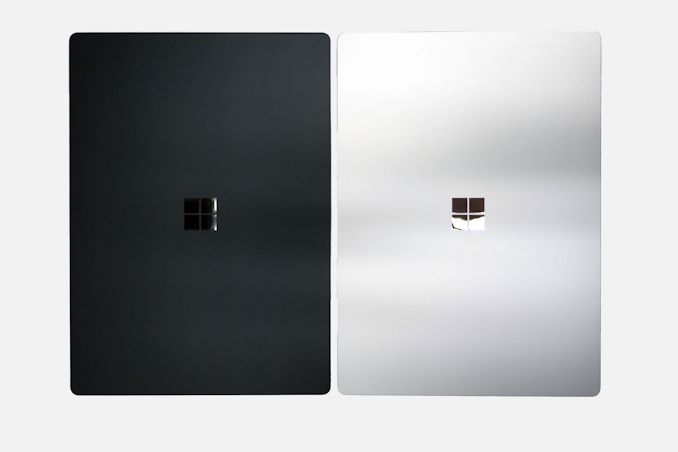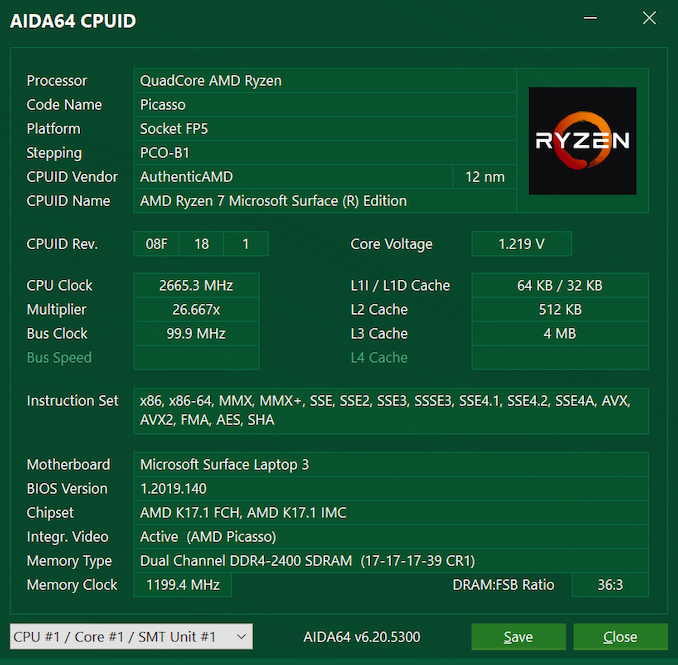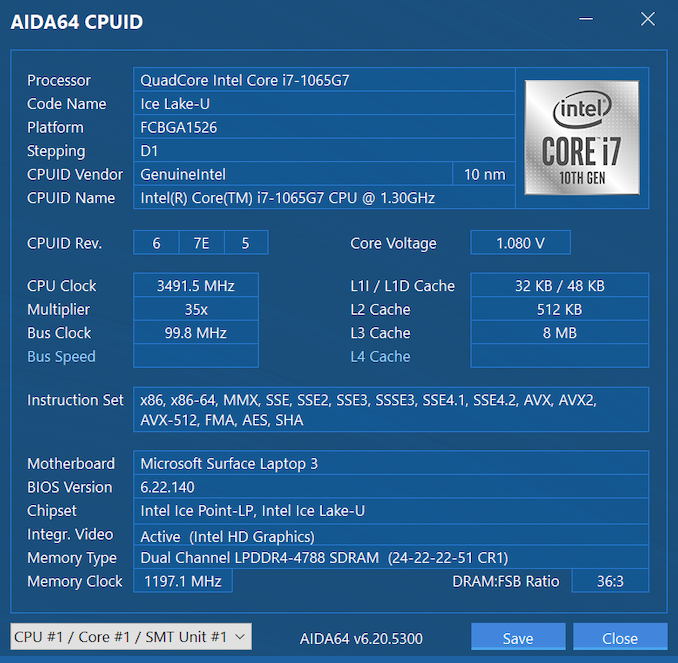The Microsoft Surface Laptop 3 Showdown: AMD's Ryzen Picasso vs. Intel's Ice Lake
by Brett Howse & Andrei Frumusanu on December 13, 2019 8:30 AM EST
Occasionally the stars align. It is very rare in the laptop space that we're able to test two devices, with two very different CPU platforms, with the fewest number of variables possible. But those stars have aligned in 2019, and thanks to Microsoft's Surface Laptop 3 family, we have a rare opportunity to compare AMD and Intel's current-generation laptop platforms in a way that wouldn't normally be possible.
In October at Microsoft’s Surface product launch in New York City, the Redmond company announced the new Surface Laptop 3 family, complete with a new 15-inch model. But what was particularly interesting for us is that the company launched not one, but two variants of this laptop: a consumer model based on AMD's Ryzen "Picasso" Zen+ APU platform, and a corporate model based on Intel's Ice Lake-U platform. And today we're going to get a chance to compare both of these laptops, pitting the top-end Ryzen 7 3780U model against the equally top-end Core i7-1065G7 model.
Microsoft sampled the Ryzen 5 3580U at the launch, and if you’ve not seen the Surface Laptop 3 review, be sure to check that out as well as it goes over the laptop in detail. Today’s focus will be strictly on what is inside.
| Microsoft Surface Laptop 3 Showdown | ||||||
| 15-Inch Consumer (AMD) |
15-Inch Enterprise (Intel) |
|||||
| Processor | AMD Ryzen 7 3780U 4C/8T, 2.3-4.0GHz, 15w |
Intel Core i7-1065G7 4C/8T, 1.3-3.9GHz, 8MB L3, 10nm |
||||
| Memory | 16 GB Dual-Channel DDR4-2400 | 16 GB Dual-Channel LPDDR4X-3733 | ||||
| Graphics | AMD Ryzen 7 3780U Vega 11 Graphics (11 CUs) |
Intel Core i7-1065G7 Intel Iris Plus "G7" Graphics (Gen 11, 64 EUs) |
||||
| Display | 15" 2496x1664 3:2 PixelSense Touch and Pen support Individually calibrated panels |
|||||
| Storage | 512 GB PCIe NVMe | 256 GB PCIe NVMe | ||||
| Networking | 802.11ac 2x2 MIMO Bluetooth 5.0 |
802.11ax Bluetooth 5.0 |
||||
| Audio | Omnisonic Speakers Dolby Audio Premium |
|||||
| Battery | 46 Wh 60 + 5 W AC Adapter |
|||||
| Right Side | Surface Connect Port | |||||
| Left Side | USB Type-A USB Type-C Headset Jack |
|||||
| Dimensions | 339.5 x 244 x 14.69 mm (13.4 x 9.6 x 0.57 inches) | |||||
| Weight | 1.54kg | |||||
| Camera | Front: 720p Camera and Windows Hello support Dual far-field Studio Mics |
|||||
| Extras | Surface Pen and Dial (sold separately) TPM 2.0 |
|||||
| Operating System | Windows 10 Home | Windows 10 Pro | ||||
| Pricing | 16GB/512GB/R7: $2099 | 16GB/256GB/i7: $1799 (16GB/512GB/i7: $2199) |
||||
As a quick refresher to the platforms we'll be testing, AMD launched the Picasso APU at CES in January 2019. Built on the GlobalFoundries' 12 nm process, it promised to be a significant upgrade to AMD's previous laptop / mobile platform, Raven Ridge. Featuring two or four cores based on AMD's Zen+ architecture, the processor peaks at 4.0 GHz in the top model. On the graphics side, AMD has continued with the Vega iGPU which has been so successful for them in the laptop space, providing significantly more 3D grunt than the previous Intel models could match.
Picasso ships with different size GPUs in terms of Compute Units (CUs) depending on the APU model. The lowest tier Ryzen 3 3200U offers just three CUs, the Ryzen 3 3300U offers six, the Ryzen 5 models offer eight, and the top-tier Ryzen 7 normally offers ten CUs. But for Microsoft and the Surface Laptop 3, AMD has quite literally taken that up to 11, with the Surface Laptop APUs coming with one additional compute unit, bringing about Vega 9 and Vega 11 respectively.
Picasso has been a solid offering, bringing a much-needed boost to AMD’s laptop focused efforts. Raven Ridge suffered from particularly high idle power draw and we were glad to see that AMD has addressed that to a degree with Picasso, although they still have work to do in that area. They also entered 2019 supporting only DDR4-2400, putting them at a disadvantage in the laptop space compared to the LPDDR that most laptops ship with, although Intel has been slow to move to LPDDR4, they’ve finally made that jump.
When it comes to Picasso and today's article, it should also be noted that like previous AMD APUs before it, AMD's fully integrated chips are about half a generation behind their discrete CPUs and GPUs. So while AMD is shipping the even newer Zen 2 architecture on desktops and servers, it's not yet available for laptops. Instead, the Zen+ based Picasso is still their current-generation platform for mobile.
On the Intel side, Microsoft opted for Intel’s Ice Lake platform for the business version of the Surface Laptop 3. Intel's latest and greatest platform, Ice Lake has seen a rough bring-up. Intel’s manufacturing woes are well documented, and it's only now, after more than two years of delays that Intel is shipping 10 nm chips in volume.
Intel’s Ice Lake platform features the new Sunny Cove CPU architecture, which Intel claims has an 18% higher Instruction-per-clock rate (IPC) than its outgoing Skylake microarchitecture, which has more or less played out to be pretty accurate. But the new 10 nm process is not as optimized as the outgoing 14 nm one has become, and the top-tier Ice Lake Core i7-1065G7 maxes out at just 3.9 GHz, a 20% lower clockspeed than Intel's top-tier 14 nm laptop chip, the 4.9 Ghz Comet Lake Core i7-10510U. So, while Intel’s newest CPU is still faster than the old one, things are never as clear as they may seem. With an 18% IPC increase but 20% lower peak clockspeeds, the overall net gain has not been very much. Luckily for Intel, they have enjoyed a significant historical CPU performance lead, which has buffered them somewhat in the laptop space.
But for everything going on with the CPU of Ice Lake, it's the GPU side where things really get interesting. Intel’s integrated GPU offerings have been sufficient for desktop use for quite some time – but just so. Intel has offered excellent media blocks, however the 3D gaming performance of their standard chips has been lacking, especially compared to AMD’s excellent Vega iGPU. Ice Lake addresses that in a couple of ways. The first is through their new Gen 11 graphics architecture, bringing about some minor architectural changes to improve their performance. The second is how much die space Intel is outright allocating for the GPU. In terms of the top-tier processor, the amount is a lot. The latest Intel Comet Lake Core i7-10510U processor offers 24 Execution Units (EUs) of Gen 9.5 graphics, but Intel’s Ice Lake processors offer up to 64 EUs of Gen 11 graphics.
Ice Lake also offers some new functionality, including the much-needed introduction of LPDDR4X support. LPDDR4X not only offers more memory bandwidth (up to 60.6GB/sec), but it's also available in higher capacities than the last-generation LPDDR3, finally allowing low power laptops to pack in more than 16GB of RAM. There’s also broader Thunderbolt 3 support, as well as major improvements to Modern Standby which provides a more tablet-like experience when resuming the device. It all adds up to a significantly better offering than Intel was able to achieve previously.
The Showdown
As stated earlier, it is rare to get a chance to test two different laptop platforms within the same laptop chassis. For various reasons, manufacturers typically use different chassis designs for different platforms – to accommodate things like differences in PCB sizes and batteries – making it difficult to do an apples-to-apples laptop platform comparison. Being able to review two platforms within the same laptop design is incredibly important, since as we’ve seen so many times, the manufacturer can play a significant role in overall system performance based on what the select for a laptop’s size, weight, cooling capabilities, and its SoC power limits.
Consequently, the Microsoft Surface Laptop 3 15-inch laptops are as close to an apples-to-apples comparison between Picasso and Ice Lake as you can make. They both feature the top-end processor from each manufacturer, both offer 16 GB of RAM, and both share the same chassis for cooling.
The remaining differences between the laptops are minor. The AMD laptop features a 512 GB SK-Hynix NVMe SSD, whereas the Intel one ships with a 256 GB Toshiba drive. The Intel laptop features an Intel Wi-Fi 6 wireless adapter, and the AMD model offers a Qualcomm Wi-Fi 5 model. And, the AMD laptop features the black anodized aluminum finish, and the Intel version is silver. None of which should impact our testing too significantly.












174 Comments
View All Comments
Zoolook - Saturday, December 21, 2019 - link
@RSAUser I think you nailed it, it's better for their bottom line to dedicate 7nm chips to products with higher margins.shabby - Friday, December 13, 2019 - link
What is amd waiting for with zen 2 for mobile? Are they prioritizing desktop and server chips first or is there a lack of capacity at tsmc with everyone hogging the 7nm process?RBD117 - Friday, December 13, 2019 - link
I think it's a mix of everything. Renoir is being worked on actively but AMD doesnt have enough resources to do all of Ryzen AM4, EPYC, and Ryzen Mobile at the same time. The desktop and server chips were prioritized first as those have clear wins over Intel solutions. Mobile however requires a lot more work with battery life and performance optimization. And yeah, we already see chip production issues with Ryzen 16 and 12-core as it is with most of the chips going to EPYC so Zen2 mobile would just add more capacity issues.Targon - Friday, December 13, 2019 - link
AMD should be releasing the Zen2 laptop chips at or around CES 2020(in another three weeks). Microsoft was probably preparing the Surface Laptop a good five months ago so AMD just didn't have samples ready for Microsoft at that time.sing_electric - Friday, December 13, 2019 - link
Realistically, TSMC's 7nm process (used in Zen 2's compute chiplets) is expensive and capacity-constrained. AMD gets around this on desktop by creating a separate IO die on an older, cheaper process, but that doesn't scale well to mobile.To get Zen 2 on mobile, they'd likely need everything - compute, IO and GPU - to be on 7nm, and the chip would be considerably larger than (desktop) Zen 2's compute chiplet.
AMD basically had a choice - for a given number of 7nm wafers, they could get a few mobile APUs or a lot more desktop CPUs (and GPUs for their 7nm options). The margins are much better doing the latter, so that's what they did.
There's also the fact that we don't know what their agreement is with Global Foundries on 14/12nm wafers - we do know that AMD's agreement with them didn't require GloFo to finish its 7nm process. AMD has a commitment to buy some number of wafers from GloFo per year for a certain length of time, and it's likely that is a factor as well.
lmcd - Friday, December 13, 2019 - link
Disagreed -- cheaper IO dies have worked on mobile for years. The "cheaper" process is literally the process Zen+ shipped with.Problem is entirely integration -- now that Navi (a major release) has shipped, AMD can integrate the current version into chiplet form, then port those integrations to the incremented version of Navi ready to ship next year. Since the chiplets provide a substantial level of decoupling, incremental upgrades should be reasonably easy to integrate.
RSAUser - Friday, December 13, 2019 - link
Doubt the I/O die size matters in this case, doesn't scale down well so not an issue.Most likely a supply issue and getting Navi to integrate.
scineram - Monday, December 16, 2019 - link
What Navi?AnGe85 - Friday, December 13, 2019 - link
AMD is a smaller company with fewer resources, as you can see with various things. The step by step Navi Launch (currently only Navi 14 is additionally available), delayed 3950X launch, the fragmented Threadripper launch, not until early 2020 Renoir with Zen2, but only combined with Vega (not Navi) and there's still the question when desktop APUs will hit the market.The new suface models presumably have been in development for about a year or even longer. There was no mobile Zen2 in sight ... and this also applies to Apple's Mac Pro and stupid demands like "it should have been Threadripper, not Xeon W". There was no appealing Threadripper available (the old 2000 series still has various flaws and limits and the Mac Pro is an even more complex platform).
Additionally at this point, I would assume, that Microsofts strategy (with the two AMD and ARM models) is more about keeping Intel in check according to pricing and cooperation.
The ARM Pro X has obvious limits and Microsoft also knew about AMDs comparability in advance. Additionally you can assume, that there is a good reason for Microsoft to offer channel consumers to the AMD 15" model (and to limit the Ice Lake model to business users), most likely, because they have to sell x K SKUs to make this experiment (or this Intel pressurizing model?) worthwhile. Maybe with next surface updates in 2021 AMD will be more competitive.
5080 - Friday, December 13, 2019 - link
Margins. EPYC, Threadripper have a much higher margin than mobile APU's.